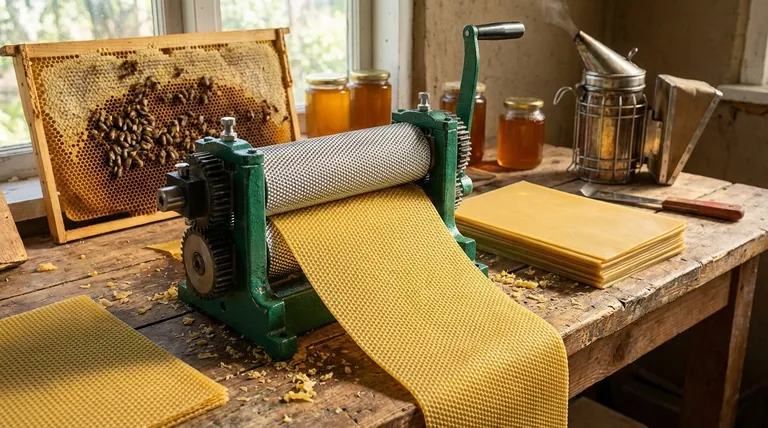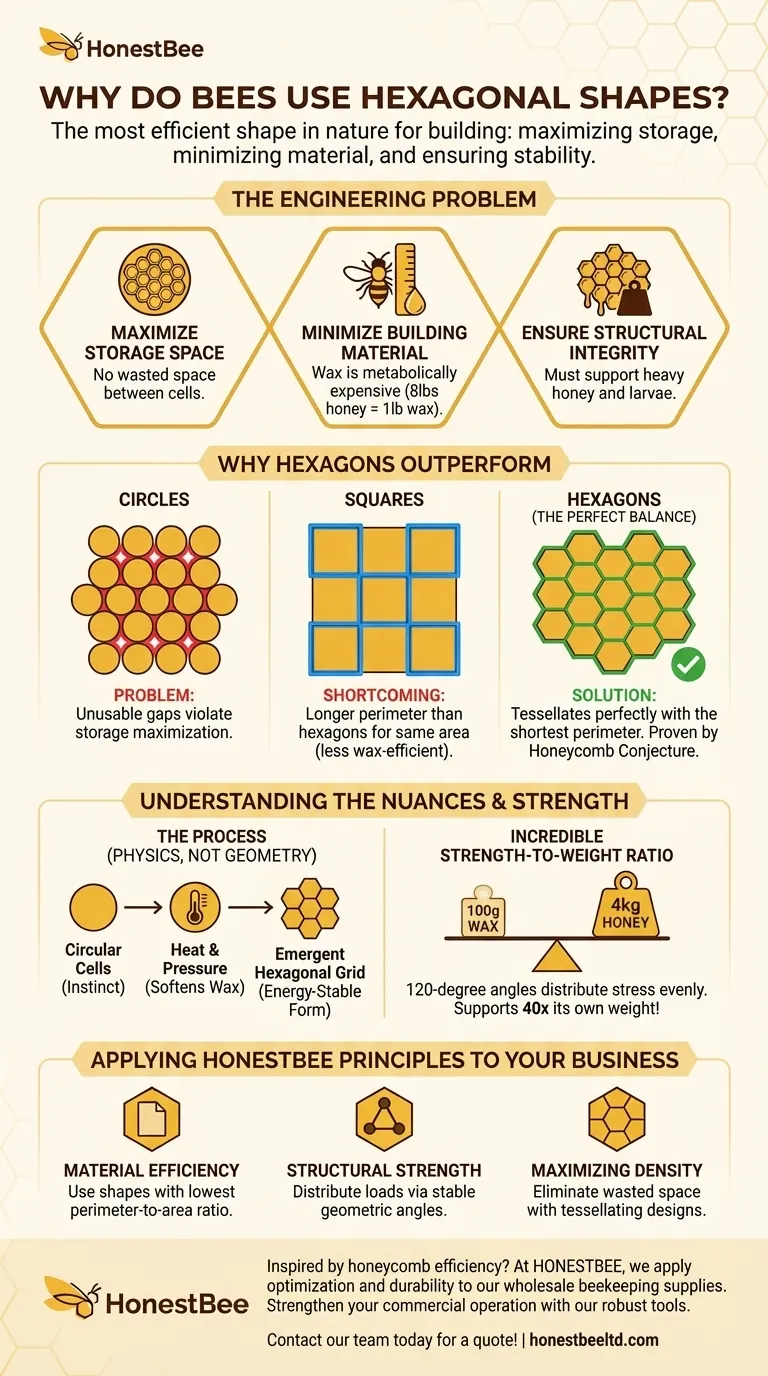Bees use hexagons for one simple reason: it is the most efficient shape in nature for building. A hexagonal grid uses the least amount of material—in this case, wax—to create a lattice of cells with the maximum possible storage space and structural integrity. It is a perfect solution honed by millions of years of evolution.
The honeycomb's hexagon isn't a random choice; it's the mathematically optimal solution to a complex engineering problem. It represents the perfect compromise between minimizing building materials, maximizing storage capacity, and ensuring structural stability.

The Engineering Problem Bees Must Solve
To understand the genius of the hexagon, we must first understand the challenges bees face. They need a structure that meets three critical engineering requirements.
Maximizing Storage Space
A colony's survival depends on storing as much honey and pollen as possible. The shape of the storage cells must therefore be space-efficient, leaving no wasted gaps between them.
Minimizing Building Material
Bees must consume about eight pounds of honey to produce just one pound of beeswax. This makes wax a metabolically expensive resource that cannot be wasted on inefficient design. The ideal shape must enclose a given area with the shortest possible perimeter.
Ensuring Structural Integrity
A finished honeycomb is incredibly heavy. The structure must be strong enough to support not only the weight of the honey but also the developing bee larvae, all while being constructed from a relatively fragile material.
Why Hexagons Outperform Other Shapes
When evaluated against these needs, the hexagon emerges as the only shape that perfectly satisfies all conditions. Other common shapes, like circles and squares, have critical flaws.
The Problem with Circles
A circle is technically the most efficient shape for holding the most area with the least perimeter. However, when circles are packed together, they leave unusable gaps, violating the need to maximize storage space.
The Shortcoming of Squares
Squares, triangles, and hexagons are the only regular polygons that can tessellate, meaning they fit together on a flat surface without leaving any gaps. While squares solve the gap problem, a square requires a longer perimeter than a hexagon to enclose the same amount of area, making it less wax-efficient.
The Hexagon's Perfect Balance
The hexagon is the superior choice because it both tessellates perfectly and has the shortest perimeter of any shape that can. This principle is so fundamental that it was proven mathematically in the "Honeycomb Conjecture" in 1999. It is the ideal middle ground, providing maximum storage with minimum material cost.
Understanding the Trade-offs and Nuances
While we admire the honeycomb's perfect geometry, the process is less about bees being master architects and more about them leveraging physics.
It's Not Conscious Geometry
Bees do not consciously measure angles. This hexagonal structure is an emergent property driven by instinct and physical forces. Bees build roughly circular cells close together.
The Power of Heat and Pressure
The heat generated by the bees' bodies softens the wax. The surface tension and pressure from surrounding cells then pull the circular structures into the most energy-stable, compact form possible—a perfect grid of hexagons.
An Incredible Strength-to-Weight Ratio
The final structure is a testament to efficient design. The 120-degree angles at which the walls of the cells meet are ideal for distributing stress evenly. This allows a honeycomb weighing just 100 grams to support up to 4 kilograms of weight, a remarkable feat of natural engineering.
How to Apply This to Your Project
The principles behind the honeycomb's design are not limited to bees. They offer powerful lessons for engineering, design, and logistics.
- If your primary focus is material efficiency: Use shapes with the lowest perimeter-to-area ratio that can tile, with the hexagon being the ideal choice.
- If your primary focus is structural strength: Distribute loads across shared walls and stable geometric angles, just as a honeycomb does.
- If your primary focus is maximizing density: Ensure your design uses shapes that tessellate, eliminating any wasted space between units.
The honeycomb stands as a masterclass in optimization, demonstrating how simple physical principles can produce extraordinarily robust and efficient structures.
Summary Table:
| Requirement | Why Hexagons Excel |
|---|---|
| Maximize Storage | Tessellates perfectly, leaving zero wasted space between cells. |
| Minimize Material (Wax) | Has the shortest perimeter-to-area ratio of any tessellating shape. |
| Ensure Structural Integrity | 120-degree angles distribute stress evenly for incredible strength. |
Inspired by the efficiency of the honeycomb? At HONESTBEE, we apply the same principles of optimization and durability to our beekeeping supplies. We provide commercial apiaries and beekeeping equipment distributors with the robust, high-quality tools needed to build a strong and productive operation. Let's discuss how our wholesale-focused solutions can strengthen your business. Contact our team today for a quote!
Visual Guide

Related Products
- Manual Beeswax Comb Foundation Machine Wax Foundation Mill Embossing Machine
- Food Grade Plastic bee Foundation for Bee Frames
- Beeswax Foundation Sheets Beehive Foundation for Wholesale
- Electric Beeswax Foundation Machine With Operating Tray and Wax Foundation Roller
- Professional Frame Preparation: The HONESTBEE Electric Wire Embedder
People Also Ask
- How do honeybees use wax in their hives? The Key to Colony Survival and Structure
- What texture is embossed on the beeswax foundation machine? The Precise Worker Bee Cell Pattern for Hive Efficiency
- What are the different uses of comb in a bee hive? A Guide to the Hive's Essential Architecture
- What is wax foundation made of? The Essential Guide to Pure Beeswax Foundations
- What is the use of a comb foundation mill? Boost Honey Production with Strategic Hive Control



















